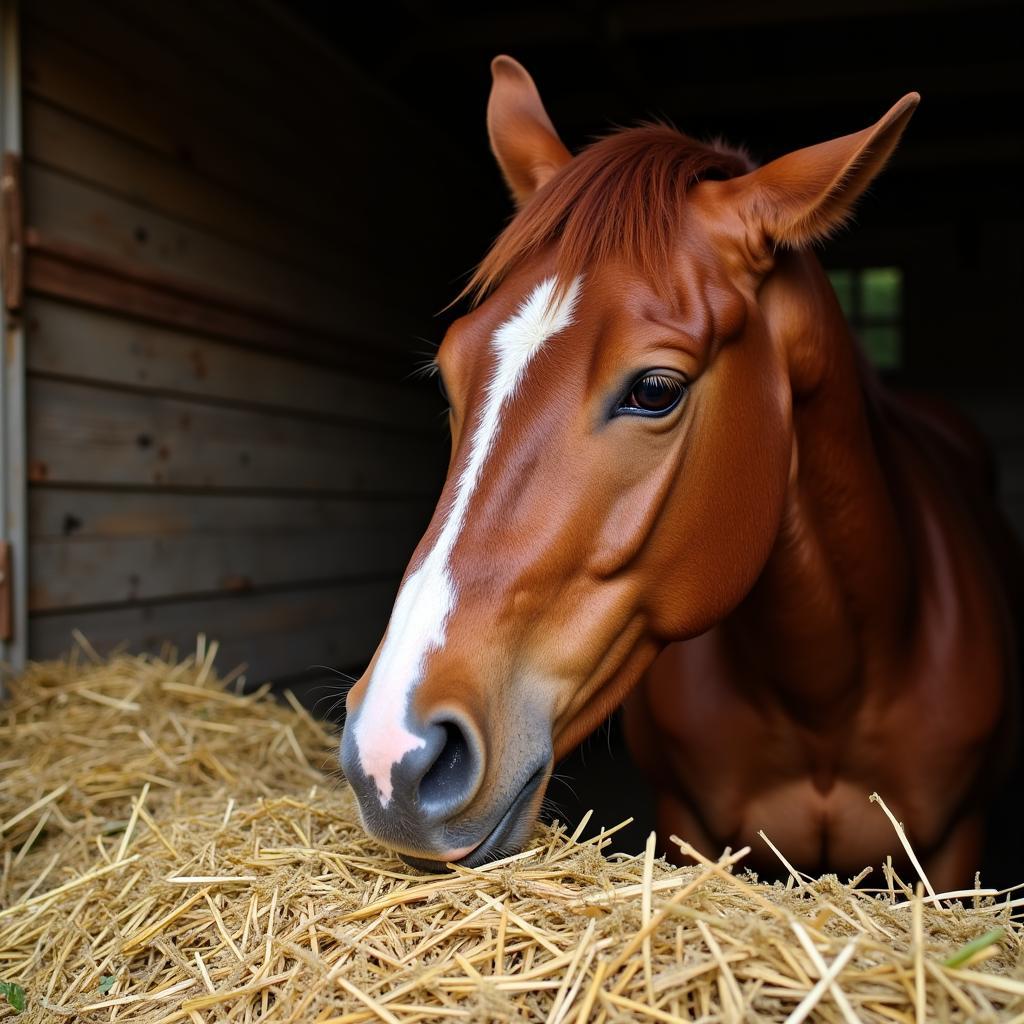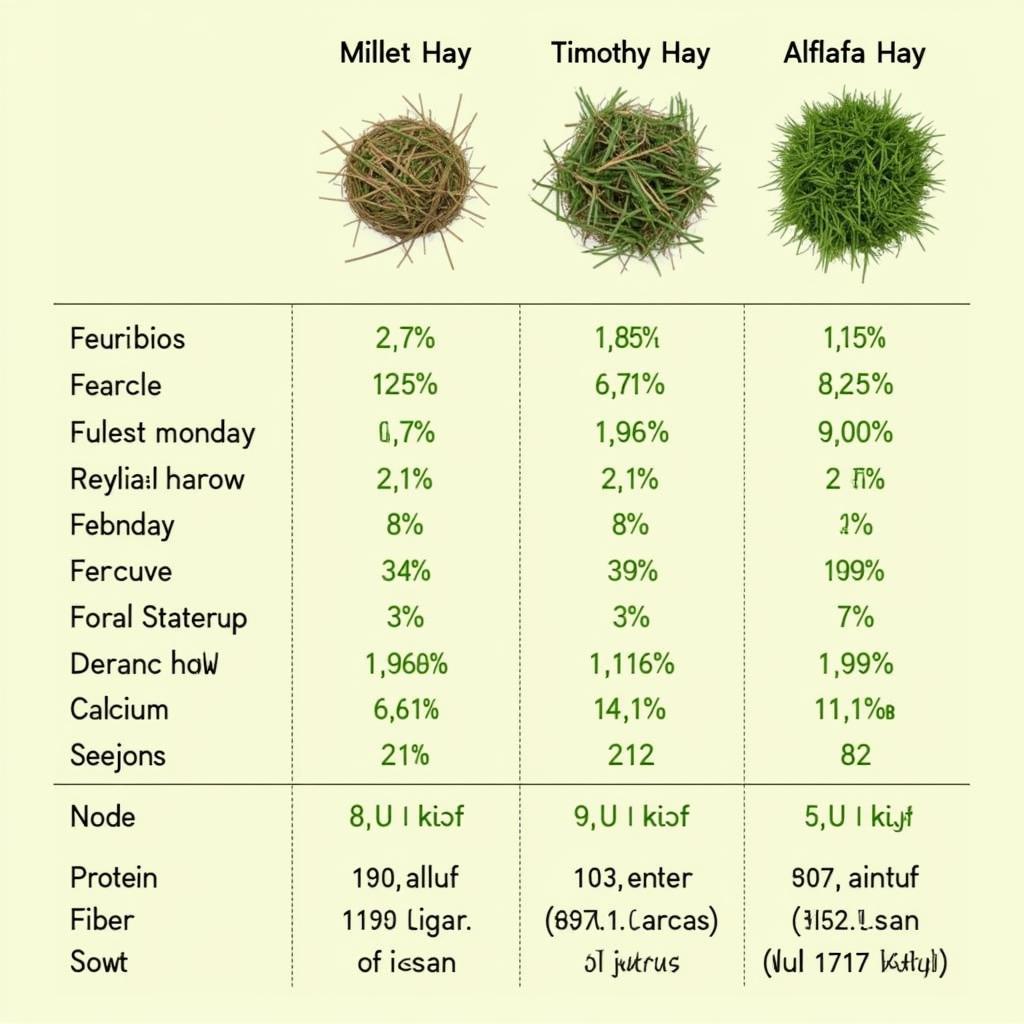Millet Hay For Horses is a topic of much discussion amongst horse owners. Is it a suitable forage? What are the benefits and drawbacks? This comprehensive guide dives deep into the world of millet hay, exploring its nutritional value, suitability for different horses, and best practices for feeding.
Understanding Millet Hay
Millet hay is derived from the millet plant, a cereal grain known for its drought tolerance and rapid growth. It’s a popular forage option in certain regions, particularly where other hay types like alfalfa or timothy are less readily available. But is it the right choice for your horse?
Nutritional Profile of Millet Hay
Millet hay offers a decent nutritional profile, though it varies depending on the specific variety and growing conditions. Generally, it’s lower in protein and calcium than alfalfa but higher in fiber than other grains. This makes millet hay a good option for horses requiring a lower protein diet, such as those prone to laminitis or other metabolic issues. It also provides a good source of energy, making it suitable for working horses with moderate energy requirements.
Compared to other common hays like timothy hay, millet hay typically has a higher calorie content, making it a good choice for hard keepers or horses needing to gain weight. It also tends to be more palatable than some other grass hays, thanks to its finer stems and softer texture, encouraging even picky eaters to consume adequate forage.
 Horse Enjoying Millet Hay
Horse Enjoying Millet Hay
Different Types of Millet Hay
Several varieties of millet are used for hay production, each with its unique characteristics. Pearl millet is the most common type, known for its high yield and drought resistance. Other varieties, like foxtail millet and proso millet, are also utilized depending on regional availability and specific needs. Knowing the specific variety you’re feeding can help you better manage your horse’s diet.
Is Millet Hay Right for Your Horse?
While millet hay can be a valuable forage option, it’s not suitable for all horses. For instance, horses with insulin resistance or Cushing’s disease should avoid millet hay due to its higher non-structural carbohydrate (NSC) content. Similarly, growing horses or lactating mares might require a hay with higher protein and calcium levels than millet can offer.
 Comparison of Millet Hay with Other Hays
Comparison of Millet Hay with Other Hays
Feeding Millet Hay to Horses
If you decide that millet hay is a good fit for your horse, there are certain best practices to follow. Always introduce any new hay gradually to avoid digestive upset. Monitor your horse’s weight and body condition to ensure the hay is meeting their nutritional needs. And as with any forage, ensure the hay is free of mold, dust, and weeds.
How Much Millet Hay Should You Feed?
The amount of millet hay you feed will depend on your horse’s individual needs, including their size, activity level, and overall health. A general guideline is to feed 1.5-2% of the horse’s body weight in forage daily. However, always consult with your veterinarian or equine nutritionist for personalized recommendations.
Benefits of Millet Hay for Horses
- Palatability: Many horses find millet hay tasty.
- Good source of fiber: Supports digestive health.
- Suitable for easy keepers: Helps maintain healthy weight.
Potential Drawbacks of Millet Hay
- Higher NSC content: Not ideal for horses with metabolic issues.
- Lower in protein and calcium: Might not meet the needs of growing or lactating horses.
- Regional availability: Can be challenging to source in some areas.
Conclusion
Millet hay for horses can be a beneficial forage option when used appropriately. Understanding its nutritional profile, potential benefits and drawbacks, and proper feeding practices are essential for ensuring your horse’s health and well-being. By considering these factors, you can make informed decisions about incorporating millet hay into your horse’s diet.
FAQ
- Can I feed millet hay to my pregnant mare? Consult with your vet, as she may need hay with higher protein and calcium.
- Is millet hay good for horses with laminitis? Generally, yes, due to its lower protein and calcium content, but consult your vet.
- Where can I buy millet hay? Local feed stores or online retailers specializing in equine feed.
- How should I store millet hay? In a dry, well-ventilated area to prevent mold growth.
- Can I mix millet hay with other hays? Yes, gradual introduction and monitoring are key.
- What are the signs of poor-quality millet hay? Dust, mold, weeds, musty odor.
- Is millet hay more expensive than other hays? Cost varies by region and availability.
Need More Help?
For further assistance with your horse care needs, including personalized dietary recommendations, contact us: Phone: 0772127271, Email: [email protected], or visit us at QGM2+WX2, Vị Trung, Vị Thuỷ, Hậu Giang, Việt Nam. We have a 24/7 customer support team ready to assist you. Explore more helpful articles on horse care and nutrition on our website, Justus Horses USA. We also have articles about caring for other pets.